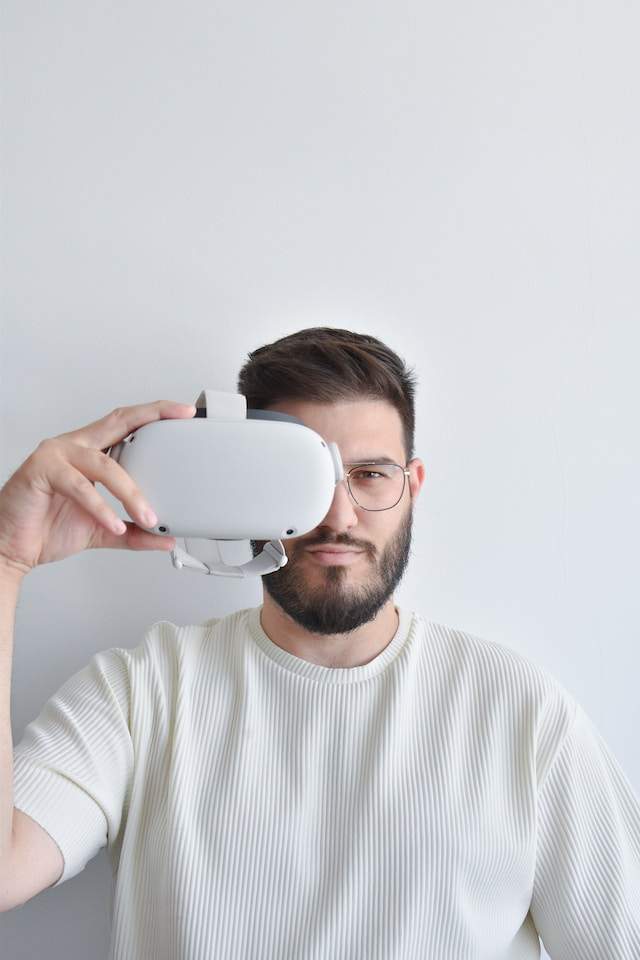The Evolution of Virtual Reality: From Early Beginnings to the Metaverse

Virtual reality (VR) technology has come a long way since its early beginnings in the 1960s. Here are some key milestones in the evolution of VR:
The Birth of VR
In the 1960s, Ivan Sutherland developed the first head-mounted display (HMD), which allowed users to see computer-generated images overlaid onto the real world. This technology was the first step towards true virtual reality.
The 1990s
The 1990s saw the emergence of commercial VR technologies, such as the Virtuality arcade machines and the Nintendo Virtual Boy. While these early systems were primitive by today’s standards, they laid the foundation for future VR development.
The 2000s
The 2000s saw renewed interest in VR, driven in part by advancements in graphics processing and display technology. Companies such as Oculus and HTC began to develop consumer VR headsets, and the first VR applications for gaming and entertainment began to emerge.
The Metaverse
The concept of the Metaverse, a fully immersive virtual world that connects multiple virtual environments, was first popularized in Neal Stephenson’s 1992 novel Snow Crash. Today, companies such as Facebook and Epic Games are working to develop Metaverse platforms that could transform the way we interact with digital content and each other.
Advancements in Technology
Recent years have seen major advancements in VR technology, including improvements in display resolution, haptic feedback, and hand tracking. These developments have helped to create more immersive and realistic VR experiences than ever before.
As VR technology continues to evolve, it is likely that we will see even more sophisticated and immersive virtual experiences emerge. From the early days of the HMD to the Metaverse and beyond, the evolution of virtual reality is a testament to human ingenuity and our ongoing quest to push the boundaries of what is possible.
What is the Metaverse and How Does it Differ from Traditional Virtual Reality?
The Metaverse is a term that refers to a shared virtual space that allows users to interact with each other and digital objects in a fully immersive and interactive way. While traditional virtual reality (VR) systems typically involve single-player experiences in isolated environments, the Metaverse is designed to be a connected and collaborative space that can be accessed by anyone with an internet connection.
One of the key differences between the Metaverse and traditional VR is the level of social interaction and collaboration it enables. In the Metaverse, users can interact with each other in real-time, collaborate on projects, attend virtual events, and even conduct business transactions. This creates a sense of community and belonging that is not present in traditional VR environments.
Another important difference between the Metaverse and traditional VR is the level of immersion and realism. While traditional VR systems rely on visual and auditory cues to create a sense of presence, the Metaverse is designed to be a fully immersive and multi-sensory experience. Users can interact with digital objects in a natural and intuitive way, and the environment can respond to their actions in real-time.
Overall, the Metaverse represents a new paradigm for virtual reality that emphasizes connectivity, collaboration, and immersive experiences. As this technology continues to evolve, it is likely that we will see even more advanced and sophisticated Metaverse platforms emerge, transforming the way we interact with each other and the digital world around us.
The Benefits and Challenges of Metaverse Platforms
Metaverse platforms have the potential to transform the way we interact with digital content and each other, but they also come with a number of benefits and challenges. Here are some of the key advantages and obstacles associated with creating a Metaverse platform:
Benefits:
- Enhanced Collaboration: Metaverse platforms can enable users to collaborate and work together in a fully immersive and interactive way. This can be especially beneficial for remote teams or individuals who are separated by distance.
- Improved Social Interaction: Metaverse platforms can create a sense of community and belonging that is not present in traditional VR environments. Users can interact with each other in real-time, attend virtual events, and even conduct business transactions.
- New Business Opportunities: Metaverse platforms can open up new opportunities for businesses to reach customers and connect with partners. For example, a Metaverse platform could allow retailers to showcase their products in a fully immersive and interactive way, or enable service providers to conduct virtual consultations with clients.
Challenges:
- Technical Complexity: Creating a Metaverse platform can be a highly complex and technically challenging endeavor. It requires expertise in areas such as 3D modeling, game design, network architecture, and software engineering.
- User Adoption: For a Metaverse platform to be successful, it must be adopted by a critical mass of users. Achieving this level of adoption can be difficult, especially if the platform is new or lacks compelling content.
- Privacy and Security: Metaverse platforms may raise privacy and security concerns, especially if users are required to share personal information or conduct financial transactions within the platform. Ensuring the security and privacy of user data will be a key challenge for Metaverse platform developers.
Overall, creating a Metaverse platform can be a challenging but rewarding undertaking. By leveraging the power of immersive technology and social interaction, Metaverse platforms have the potential to transform the way we work, play, and connect with each other. However, developers must also navigate a range of technical, social, and ethical challenges in order to make these platforms successful.
The Future of Virtual Reality: Emerging Technologies and Trends
The field of virtual reality (VR) is rapidly evolving, with new technologies and trends emerging all the time. Here are some of the most promising developments to look out for in the future of VR:
1. Augmented Reality (AR)
While VR typically involves creating a fully immersive digital environment, AR combines digital content with the real world. AR headsets, such as the Microsoft HoloLens, allow users to interact with digital objects overlaid onto their physical surroundings. AR technology is being used in a wide range of applications, from gaming and entertainment to education and training.
2. Mixed Reality (MR)
MR combines elements of VR and AR, allowing digital content to interact with the physical environment in a more realistic way. MR headsets, such as the Magic Leap One, use sensors and cameras to track the user’s movements and adjust the digital content accordingly. This technology has many potential applications, from architecture and design to healthcare and manufacturing.
3. Eye-Tracking:
Eye-tracking technology allows VR systems to accurately detect where the user is looking, enabling more natural and intuitive interaction. This can improve the overall experience and reduce the risk of motion sickness. Eye-tracking is also being used for applications such as gaze-based control and foveated rendering, which can improve performance and reduce hardware requirements.
4. Haptic Feedback
Haptic feedback technology uses sensors and actuators to provide tactile sensations to the user, simulating the sense of touch. This can enhance immersion and improve the overall experience, especially for applications such as gaming and training. Haptic feedback devices are becoming more advanced and affordable, making them accessible to a wider range of users.
5. Social VR:
Social VR platforms, such as Facebook Horizon and VRChat, enable users to interact with each other in a virtual space. These platforms can create a sense of community and foster social interaction, allowing users to connect with people from around the world. Social VR is expected to become an increasingly important application of VR technology in the future.
Overall, the future of VR is likely to be characterized by a range of emerging technologies and trends, each with its own unique applications and potential benefits. As the technology continues to evolve and mature, we can expect to see even more advanced and sophisticated VR systems emerge, transforming the way we work, play, and interact with the digital world.
Beyond the Metaverse: Exploring the Next Frontier of Virtual Reality with using the keyword- Metaverse Development Services
While the metaverse represents an exciting and rapidly evolving field of virtual reality, there are many other frontiers to explore beyond it. Here are some of the most promising areas of development in virtual reality, and how Metaverse Development Services can play a role in shaping their future:
1. Augmented Reality (AR):
As mentioned previously, AR is a form of mixed reality that combines digital content with the real world. Metaverse Development Services can leverage their expertise in creating immersive digital environments to create compelling AR experiences that seamlessly blend the physical an2. Extended Reality (XR):
XR is an umbrella term that encompasses virtual, augmented, and mixed reality. It refers to any technology that blurs the line between the physical and virtual worlds. Metaverse Development Services can help clients create cutting-edge XR experiences that push the boundaries of what is possible with current technology.
3. Virtual Commerce:
With the rise of e-commerce, virtual commerce represents a promising new frontier for retailers. Virtual commerce involves creating virtual storefronts, allowing customers to browse and purchase products in a fully immersive digital environment. Metaverse Development Services can help retailers create engaging and immersive virtual shopping experiences that replicate the in-store experience in a digital format.
4. Virtual Events:
With the ongoing COVID-19 pandemic, virtual events have become increasingly popular. From conferences to concerts, virtual events allow people to gather and connect in a safe and immersive digital environment. Metaverse Development Services can help event organizers create custom virtual event spaces that deliver a seamless and engaging experience for attendees.
5. Virtual Tourism:
With travel restrictions in place around the world, virtual tourism represents an exciting new opportunity for people to explore new destinations without leaving their homes. Metaverse Development Services can create stunning virtual environments that transport users to far-flung locations, providing a realistic and immersive travel experience.
In summary, the world of virtual reality is vast and ever-expanding, with many exciting frontiers to explore beyond the metaverse. As a leading provider of Metaverse Development Services, our team is well-positioned to help clients create cutting-edge virtual experiences that push the boundaries of what is possible with current technology.
Ethics and Responsibility in the Future of Virtual Reality Development
As virtual reality continues to evolve and become more sophisticated, it is important to consider the ethical and moral implications of its development and use. Here are some key considerations for ethics and responsibility in the future of virtual reality development:
1. Privacy:
Virtual reality platforms often collect user data, including biometric data such as heart rate and pupil dilation. Developers must be transparent about how user data is collected, stored, and used, and must obtain user consent for its use.
2. Accessibility:
Virtual reality should be accessible to everyone, including people with disabilities. Developers must design platforms that are inclusive and accommodate a wide range of needs and abilities.
3. Safety:
Virtual reality can be physically and mentally intense, and developers must take steps to ensure the safety and well-being of users. This includes measures to prevent motion sickness, eyestrain, and other health issues, as well as guidelines for safe use of the technology.
4. Representation:
Virtual reality platforms should reflect the diversity of the real world, and developers must be mindful of the potential for unconscious bias in their design and development decisions. This includes considering factors such as race, gender, and sexual orientation in the creation of avatars and other virtual elements.
5. Responsibility:
Developers have a responsibility to ensure that their virtual reality platforms are not used for harmful or unethical purposes. This includes preventing harassment, hate speech, and other forms of abuse within virtual environments.
Ultimately, the development of virtual reality must be guided by ethical considerations and a sense of responsibility to users and society as a whole. As a leading provider of virtual reality development services, it is our responsibility to ensure that our platforms are designed and developed with these considerations in mind, and that we are actively working to create a more inclusive, equitable, and responsible future for virtual reality.
Conclusion: Virtual Reality and the Future of Human Experience.
Virtual reality has the potential to revolutionize the way we experience the world around us, offering new and exciting opportunities for entertainment, education, and social interaction. As the technology continues to evolve and mature, it is likely that we will see the emergence of new and innovative virtual reality platforms that are more immersive, interactive, and lifelike than ever before.
At the same time, it is important to consider the ethical and moral implications of virtual reality development and use, and to ensure that the technology is designed and deployed in a responsible and inclusive manner.
By working together to address these challenges and opportunities, we can help to create a future in which virtual reality enhances and enriches our lives in countless ways, while also promoting greater understanding, empathy, and connection between individuals and communities around the world.

